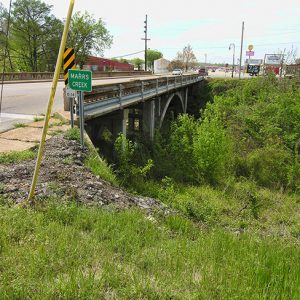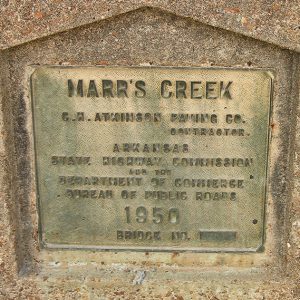calsfoundation@cals.org
Marr's Creek Bridge
The Marr’s Creek Bridge is a reinforced concrete bridge with an open spandrel arch. It was built to carry U.S. Highways 62 and 67, as well as South Bettis Street, over Marr’s Creek in Pocahontas (Randolph County) near its confluence with Black River, although the bridge is no longer an active part of Highway 67. The Marr’s Creek Bridge was an important component of New Deal recovery programs in Arkansas and was constructed in 1934 as one of the Public Works Administration (PWA) projects in Arkansas.
The construction of Highway 67 and its subsequent bridges, including the 135-foot-long Marr’s Creek Bridge, was a part of a larger modernization campaign to rebuild Highway 67 into Pocahontas. This campaign created jobs within Arkansas and contributed to improving the business climate of the communities it served. The National Industrial Recovery Act (1933) ensured adequate funding for PWA projects, including over $6,000,000 for Arkansas highway construction. Coupled with other federal funds, over $1,000,000 was invested in upgrading Highway 67 during the 1933–1934 road building program.
The Little Rock (Pulaski County) office of the Luten Bridge Company bid for and won the contract to construct the Marr’s Creek Bridge in 1933. N. B. Garver served as the lead design engineer, and construction began the following year.
The Marr’s Creek Bridge is an example of the “Luten Arch” bridge, patented by Daniel B. Luten, founder of the Luten Bridge Company. Luten’s bridge design strategically reinforced and addressed tension and load weight of arched bridges. Only several of these bridges remain in the state; many have been added to the National Register of Historic Places or studied for the Historic American Engineering record. Only one other bridge in Arkansas, the Harp Creek Bridge on State Highway 7 in Jasper (Newton County), is of the open spandrel type like the Marr’s Creek Bridge; the other bridges are solid spandrels. By the early 1920s, Luten purportedly held thirty-nine U.S. patents and had designed thousands of bridges in the United States, Mexico, and Canada.
In 1950, the Arkansas Department of Transportation modernized the Marr’s Creek Bridge to meet traffic demand and federal highway standards. The construction added more concrete structural supports to the bridge and width to the east lanes.
The Marr’s Creek Bridge is no longer an active component of the Highway 67 roadway in Pocahontas. In October 2011, the AHTD widened Highway 67 through Pocahontas from the Black River Bridge north to form a four-lane highway in that area to decrease traffic congestion. This construction bypassed the original Marr’s Creek Bridge, but the structure was left standing.
The Marr’s Creek Bridge was added to the National Register of Historic places on January 24, 2008.
For additional information:
Arkansas State Highway Commission. Eleventh Biennial Report of the Arkansas State Highway Commission. Little Rock: Arkansas State Highway Commission, 1934.
Hope, Holly. “An Ambition to be Preferred: New Deal Recovery Efforts in Arkansas, 1933–1943.” Little Rock: Arkansas Historic Preservation Program, 2006.
“Marr’s Creek Bridge.” National Register of Historic Places nomination form. On file at Arkansas Historic Preservation Program, Little Rock Arkansas. Online at https://www.arkansasheritage.com/docs/default-source/national-registry/ra0109-pdf.pdf?sfvrsn=1472c1bf_0 (accessed December 26, 2025).
Zachary Elledge
Jonesboro, Arkansas












Comments
No comments on this entry yet.